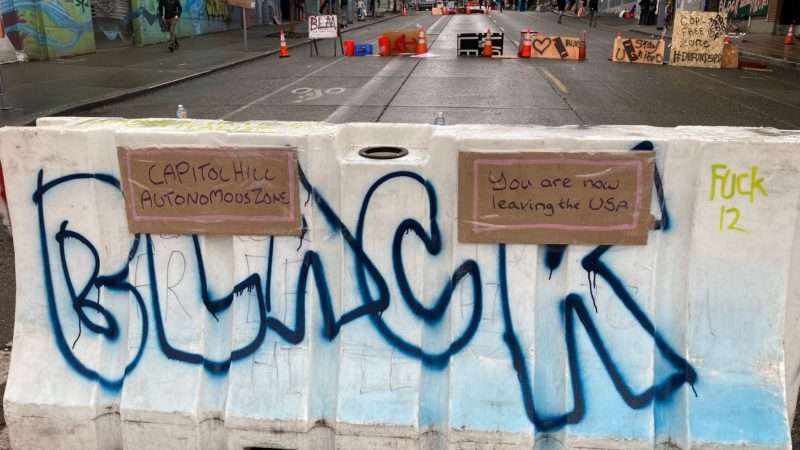Derek Chauvin, the now-former Minneapolis police officer who kneeled on George Floyd’s neck for more than eight minutes while arresting him for passing a counterfeit $20 bill on Memorial Day, has been charged with murder and manslaughter for causing Floyd’s death by using excessive force. But whether or not Chauvin is convicted, it is not clear that he would be liable under 42 USC 1983, a federal statute that allows lawsuits against police officers who violate people’s constitutional rights.
Benjamin Crump, an attorney who represents Floyd’s family, plans to file a lawsuit under that statute. Given the relevant precedents in the 8th Circuit, which includes Minnesota, it is by no means a surefire winner. The uncertainty speaks volumes about the leeway that courts tend to give cops in excessive force cases and the extent to which the doctrine of qualified immunity, which bars claims under 42 USC 1983 when the rights police allegedly violated were not “clearly established,” shields them from liability for outrageous conduct.
Chauvin, assisted by two other officers who also face criminal charges, kneeled on Floyd’s neck while he was handcuffed and restrained in a prone position. The autopsy report from the Hennepin County Medical Examiner’s Office describes the cause of death as “cardiopulmonary arrest complicating law enforcement subdual, restraint, and neck compression.” An independent autopsy commissioned by Floyd’s family said he died from “mechanical asphyxiation.” Both reports agreed that the manner of death was homicide.
In two recent cases with broadly similar facts—a handcuffed detainee who died while restrained in a prone position by several officers—the U.S. Court of Appeals for the 8th Circuit blocked claims under 42 USC 1983. Those cases may not be dispositive, since both involved detainees who were actively resisting. Although Chauvin and the other officers said Floyd initially resisted their attempts to put him in a squad car, he was under control and posed no apparent threat to them while Chauvin was kneeling on his neck. But the 8th Circuit does not seem to have previously addressed a situation quite like that, and the lack of sufficiently specific precedent is enough to trigger qualified immunity.
In the 2017 case Ryan v. Armstrong, the 8th Circuit considered the 2012 death of Jerome Harrell, who surrendered himself at the Stearns County jail in St. Cloud, Minnesota, because he had outstanding traffic warrants. During his night in jail, the court noted, Harrell “scream[ed], howl[ed], and bang[ed] against his cell door for eight hours.” The next morning, when correctional officers tried to remove him from his cell, Harrell resisted them. They handcuffed him, shackled his legs, tased him twice, and pinned him to the floor face down for three minutes.
Five minutes after the officers entered Harrell’s cell, he was no longer responsive, and jail staff could not revive him. He was pronounced dead at a hospital later that morning. The official autopsy report described the incident as a “sudden unexpected death during restraint.”
The 8th Circuit ruled that the use of force against Harrell was objectively reasonable in the circumstances. “Harrell was actively resisting the extraction procedure by
ignoring directives to lie down on his bunk and resisting the defendants’ efforts to
subdue him once they entered his cell,” the court said. “We, therefore, conclude that the defendants are entitled to qualified immunity on the trustee’s excessive force claim.”
The 2020 case Lombardo v. City of St. Louis involved the death of Nicholas Gilbert, who was arrested by St. Louis police officers in 2015 for trespassing in a condemned building and failure to appear in court after receiving a traffic ticket. “While Gilbert was in the cell,” the court noted, “the officers observed him engaging in unusual behavior, including waving his hands in the air, rattling the bars of his cell, throwing his shoe, and bobbing up and down.” One officer “observed Gilbert tie an article of clothing around the bars of his cell and his neck.” Worried that Gilbert was trying to hang himself, another officer entered the cell but found him with nothing around his neck.
The officer nevertheless started to handcuff Gilbert, precipitating a struggle in which several officers eventually handcuffed him, shackled his legs, and pinned him to the ground on his stomach. “Throughout the altercation,” the court said, “the officers controlled Gilbert’s limbs at his shoulders, biceps, legs, and lower or middle torso. While continuing to resist, Gilbert tried to raise his chest up and told the officers to stop because they were hurting him. After fifteen minutes of struggle in the prone position, Gilbert stopped resisting and the officers rolled him from his stomach onto his side.”
At that point, Gilbert had already stopped breathing, and the officers could not find a pulse. He was transported to a hospital, where he was pronounced dead. The official autopsy report said “the cause of death was arteriosclerotic heart disease exacerbated by methamphetamine and forcible restraint.” An independent medical report commissioned by Gilbert’s family said the cause was “forcible restraint inducing asphyxia.”
Citing its decision in Ryan, the 8th Circuit concluded that “the Officers’ actions did not amount to constitutionally excessive force.” The court noted that “the Officers held Gilbert in the prone position only until he stopped actively fighting against his restraints and the Officers.” And “once he stopped resisting, the Officers rolled Gilbert out of the prone position.”
By contrast with Harrell and Gilbert, Floyd was not resisting at the time of his death, except to repeatedly complain that he could not breathe. Presumably, that distinction would make a difference in the constitutional analysis, although we can’t be sure.
Another seemingly relevant difference is that Chauvin used a neck restraint, while the defendants in Ryan and Lombardo applied pressure to other parts of the detainees’ bodies. Other federal appeals courts have ruled that neck restraints are reasonable under the Fourth Amendment in some situations, primarily when the suspect is violently resisting and/or has a history of doing so, and unreasonable in others, primarily when those circumstances are lacking.
Even if the 8th Circuit followed that general trend and concluded that Chauvin’s actions were unconstitutional, it could still decide that the law on that point was not clearly established at the time of Floyd’s arrest, meaning the excessive force claim would be barred by qualified immunity. It could even reach the latter conclusion without resolving the constitutional question, as courts have commonly done since 2009, when the Supreme Court began allowing that shortcut.
Other 8th Circuit decisions have recognized that the gratuitous use of force during an arrest violates the Fourth Amendment, even when the outcome is not fatal. But that general principle is not enough to defeat qualified immunity in cases with different details.
Last year, for example, the 8th Circuit granted qualified immunity to a Nebraska sheriff’s deputy who, while responding to an erroneous “domestic assault” report, lifted the purported victim in a bear hug and threw her to the ground, knocking her unconscious and breaking her collarbone. “It was not clearly established in May 2014 that a deputy was forbidden to use a takedown maneuver to arrest a suspect who ignored the deputy’s instruction to ‘get back here’ and continued to walk away from the officer,” the court concluded. Last month the Supreme Court declined to review that decision.
To avoid dismissal of their claims, says UCLA law professor Joanna Schwartz, a leading critic of qualified immunity, Floyd’s family “would have to find cases in which earlier defendants were found to have violated the law in precisely the same way.” Thanks to qualified immunity, suggests Brett Kittredge, director of communications at the Mississippi Center for Public Policy, “Floyd’s family would likely have their claims against the officers dismissed because there isn’t a case in the 8th Circuit…or the U.S. Supreme Court specifically holding that it is unconstitutional for police to kneel on the neck of a handcuffed man for nine minutes.”
We may never find out. Last year, the city of Minneapolis reached a $20 million settlement with the family of Justine Ruszczyk Damond, who was shot to death by Officer Mohamed Noor after she called 911 to report a possible assault in the alley behind her house. Noor had already been convicted of third-degree murder. The Minneapolis Star Tribune reports that “legal experts” think the payout in Floyd’s case could “dwarf” that settlement.

from Latest – Reason.com https://ift.tt/2VBu74u
via IFTTT




